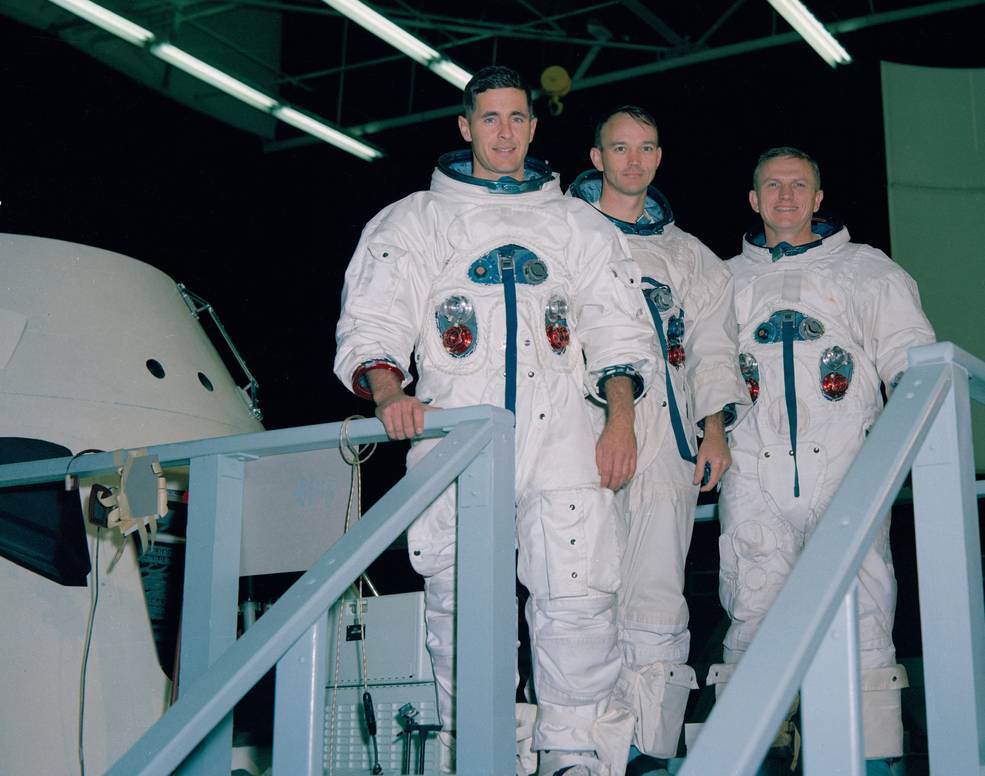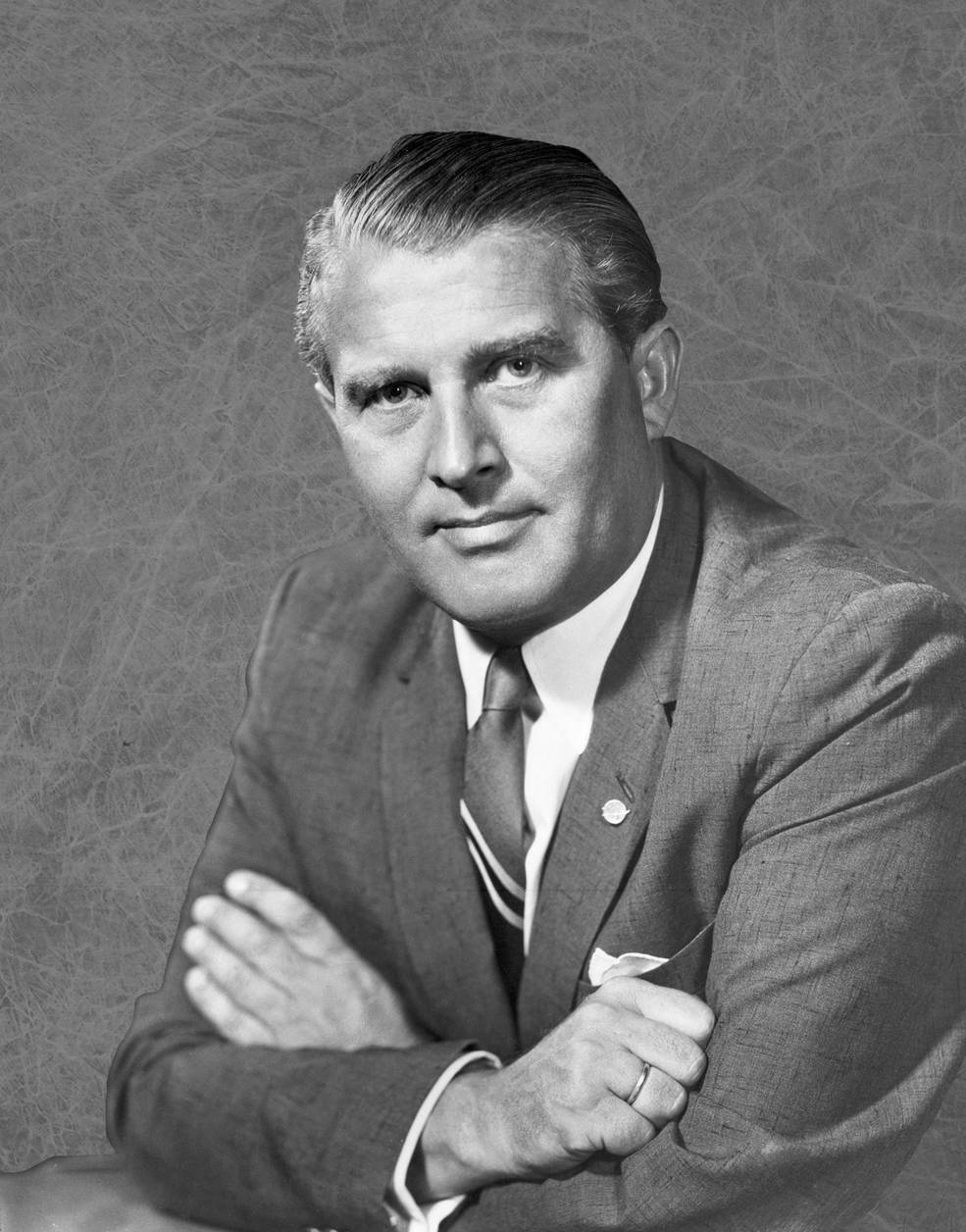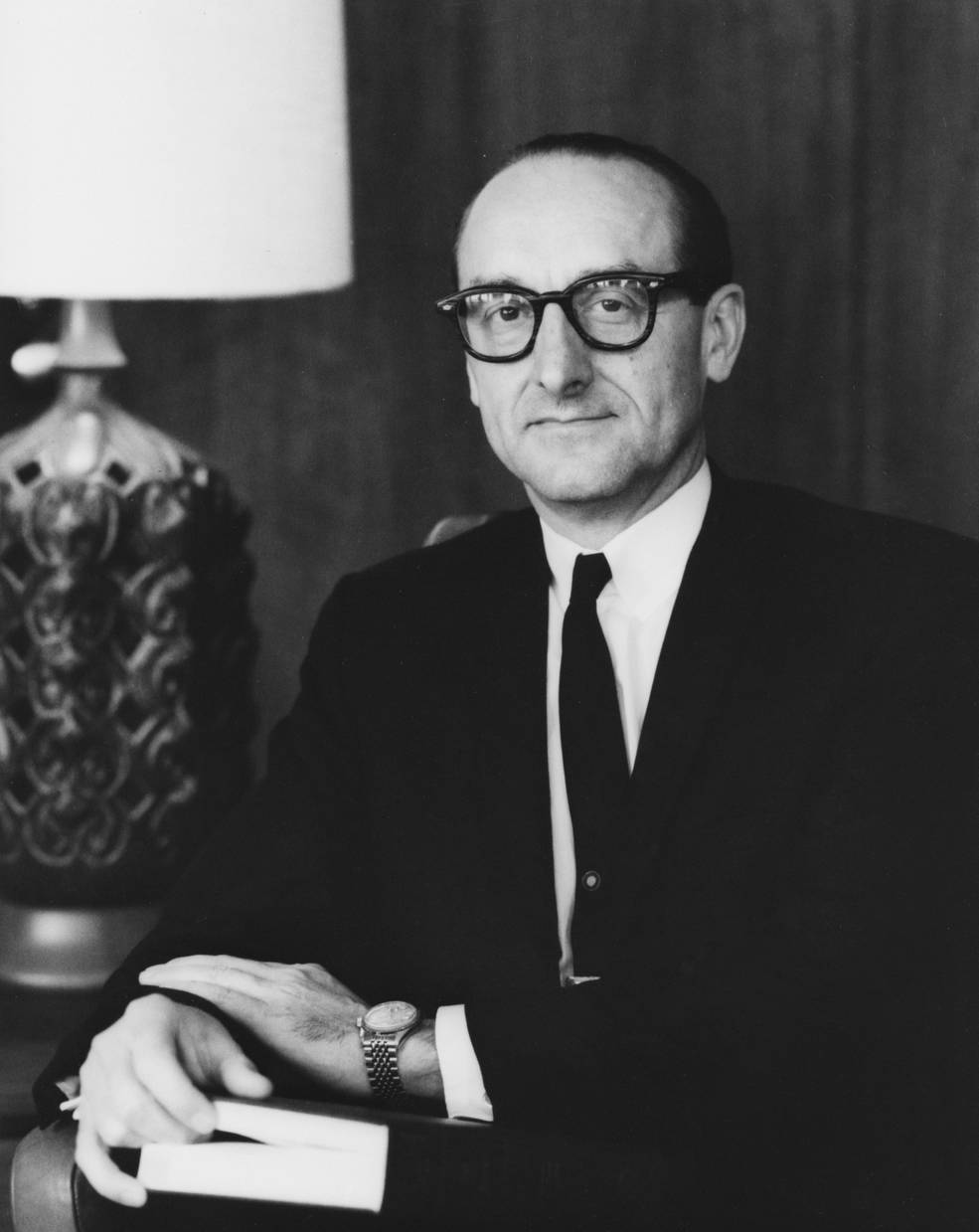In July 1968, much work still remained to meet the goal President John F. Kennedy set in May 1961, to land a man on the Moon and return him safely to the Earth before the end of the decade. No American astronaut had flown in space since the November 1966 flight of Gemini XII, the delay largely a result of the tragic Apollo 1 fire. Although the Apollo spacecraft had successfully completed several uncrewed test flights, the first crewed mission still lay three months in the future. The delays in getting the Lunar Module (LM) ready for its first flight caused schedule concerns, but also presented an opportunity for a bold step to send the second crewed Apollo mission, the first crewed flight of the Saturn V, on a trip to orbit the Moon. Using an incremental approach, three flights later NASA accomplished President Kennedy’s goal.



 Left: The charred remains of the Apollo 1 spacecraft following the tragic fire that claimed the lives of astronauts Virgil I. “Gus” Grissom, Edward H. White, and Roger B. Chaffee. Middle left: The first launch of the Saturn V rocket on the Apollo 4 mission. Middle right: The first Lunar Module in preparation for the Apollo 5 mission. Right: Splashdown of Apollo 6, the final uncrewed Apollo mission.
Left: The charred remains of the Apollo 1 spacecraft following the tragic fire that claimed the lives of astronauts Virgil I. “Gus” Grissom, Edward H. White, and Roger B. Chaffee. Middle left: The first launch of the Saturn V rocket on the Apollo 4 mission. Middle right: The first Lunar Module in preparation for the Apollo 5 mission. Right: Splashdown of Apollo 6, the final uncrewed Apollo mission.
The American human spaceflight program suffered a jarring setback on Jan. 27, 1967, with the deaths of astronauts Virgil I. Grissom, Edward H. White, and Roger B. Chaffee in the Apollo 1 fire. The fire and subsequent Investigation led to wholesale changes to the spacecraft, such as the use of fireproof materials and redesign of the hatch to make it easy to open. The early Block I spacecraft, such as Apollo 1, would now only be used for uncrewed missions, with crews flying only aboard the more advanced Block II spacecraft. The fire and its aftermath also led to management changes. For example, George M. Low replaced Joseph F. Shea as Apollo Spacecraft Program Manager. The first Apollo mission after the fire, the uncrewed Apollo 4 in November 1967, included the first launch of the Saturn V Moon rocket as well as a 9-hour flight of a Block I Command and Service Module (CSM). Apollo 5 in January 1968 conducted the first uncrewed test of the LM, and despite a few anomalies, managers considered it successful enough that they canceled a second uncrewed flight. The April 1968 flight of Apollo 6, planned as a near-repeat of Apollo 4, encountered several significant anomalies such as first stage POGO, or severe vibrations, and the failure of the third stage to restart, leading to an alternate mission scenario. Engineers devised a solution to the POGO problem and managers decided that the third flight of the Saturn V would carry a crew.


 Left: Apollo 7 astronauts R. Walter Cunningham, left, Donn F. Eisele, and Walter M. Schirra participate in water egress training. Middle: Workers stack the Apollo 7 spacecraft on its Saturn IB rocket at Launch Pad 34. Right: Schirra, left, Cunningham, and Eisele stand outside the spacecraft simulator.
Left: Apollo 7 astronauts R. Walter Cunningham, left, Donn F. Eisele, and Walter M. Schirra participate in water egress training. Middle: Workers stack the Apollo 7 spacecraft on its Saturn IB rocket at Launch Pad 34. Right: Schirra, left, Cunningham, and Eisele stand outside the spacecraft simulator.
As of July 1968, NASA’s plan called for two crewed Apollo flights in 1968 and up to five in 1969 to achieve the first lunar landing to meet President Kennedy’s deadline, with each mission incrementally building on the success of the previous ones. The first mission, Apollo 7, would return American astronauts to space following a 23-month hiatus. Planned for October 1968, the crew of Walter M. Schirra, Donn F. Eisele, and R. Walter Cunningham would launch atop a Saturn IB rocket and conduct a shakedown flight of the Block II CSM in Earth orbit, including testing the Service Propulsion System engine, critical on later lunar missions for getting into and out of lunar orbit. The flight plan remained open-ended, but managers expected to complete a full-duration 11-day mission, ending with a splashdown in the Atlantic Ocean. Preparations for Apollo 7 proceeded well during the summer of 1968. Workers had stacked the two-stage Saturn IB rocket on Launch Pad 34 back in April. In KSC’s Manned Spacecraft Operations Building (MSOB), Schirra, Eisele, and Cunningham completed altitude chamber tests of their spacecraft, CSM-101, on July 26 followed by their backups three days later. Workers trucked the spacecraft to the launch pad on Aug. 9 for mating with the rocket. Among major milestones, Schirra, Eisele, and Cunningham completed water egress training in the Gulf of Mexico on Aug. 5, in addition to spending time in the spacecraft simulators at KSC and at the Manned Spacecraft Center (MSC), now NASA’s Johnson Space Center in Houston.


 Left: The original Apollo 8 crew of Russell L. Schweickart, left, David R. Scott, and James A. McDivitt during training in June 1968. Middle: Lunar Module-3 arrives at NASA’s Kennedy Space Center (KSC) in Florida in June 1968. Right: In July 1968, workers in KSC’s Vehicle Assembly Building stack the Saturn V rocket for the Apollo 8 mission.
Left: The original Apollo 8 crew of Russell L. Schweickart, left, David R. Scott, and James A. McDivitt during training in June 1968. Middle: Lunar Module-3 arrives at NASA’s Kennedy Space Center (KSC) in Florida in June 1968. Right: In July 1968, workers in KSC’s Vehicle Assembly Building stack the Saturn V rocket for the Apollo 8 mission.
The second flight, targeting a December 1968 launch, would feature the first crewed launch of the Saturn V rocket. The Apollo 8 crew of James A. McDivitt, David R. Scott, and Russell L. Schweickart would conduct the first crewed test of the LM in the relative safety of low Earth orbit. McDivitt and Schweickart would fly the LM on its independent mission, including separating the ascent stage from the descent stage to simulate a takeoff from the Moon, while Scott remained in the CSM. After redocking, Schweickart would conduct a spacewalk to practice an external transfer between the two vehicles. Workers completed stacking the three-stage Saturn V rocket (SA-503) in KSC’s Vehicle Assembly Building (VAB) on Aug. 14. The first component of the spacecraft, LM-3, arrived at KSC on June 9, while CSM-103, arrived on Aug. 12. Workers in the MSOB began to prepare both spacecraft for flight.


 Left: The original Apollo 9 crew of William A. Anders, left, Michael Collins, and Frank Borman during training in March 1968. Middle: Lunar Module-3 during preflight processing at NASA’s Kennedy Space Center (KSC) in Florida in August 1968. Right: Following the revision of the mission plans for Apollo 8 and 9 and crew changes, the Apollo 8 crew of James A. Lovell, Anders, and Borman stand before their Saturn V rocket as it rolls out of KSC’s Vehicle Assembly Building in October 1968.
Left: The original Apollo 9 crew of William A. Anders, left, Michael Collins, and Frank Borman during training in March 1968. Middle: Lunar Module-3 during preflight processing at NASA’s Kennedy Space Center (KSC) in Florida in August 1968. Right: Following the revision of the mission plans for Apollo 8 and 9 and crew changes, the Apollo 8 crew of James A. Lovell, Anders, and Borman stand before their Saturn V rocket as it rolls out of KSC’s Vehicle Assembly Building in October 1968.
The third flight, planned for early 1969, and flown by Frank Borman, Michael Collins, and William A. Anders, would essentially repeat the Apollo 8 mission, but at the end would fire the SPS engine to raise the high point of their orbit to 4,600 miles and then simulate a reentry at lunar return velocity to test the spacecraft’s heat shield. On July 23, Collins underwent surgery for a bone spur in his neck, and on August 8, NASA announced that James A. Lovell from the backup crew would take his place. Later missions in 1969 would progress to sending the CSM and LM combination to lunar orbit, leading to the first landing before the end of the year. Construction of the rocket and spacecraft components for these future missions continued at various contractor facilities around the country.



 Left: In Mission Control during the Apollo 6 mission, Director of Flight Crew Operations Christopher C. Kraft, left, Director of the Manned Spacecraft Center, now NASA’s Johnson Space Center in Houston Robert R. Gilruth, and Apollo Spacecraft Program Manager George M. Low. Middle left: Chief of Flight Crew Operations Donald K. “Deke” Slayton. Middle right: Director of NASA’s Kennedy Space Center in Florida Kurt H. Debus. Right: Director of NASA’s Marshall Space Flight Center in Huntsville, Alabama.
Left: In Mission Control during the Apollo 6 mission, Director of Flight Crew Operations Christopher C. Kraft, left, Director of the Manned Spacecraft Center, now NASA’s Johnson Space Center in Houston Robert R. Gilruth, and Apollo Spacecraft Program Manager George M. Low. Middle left: Chief of Flight Crew Operations Donald K. “Deke” Slayton. Middle right: Director of NASA’s Kennedy Space Center in Florida Kurt H. Debus. Right: Director of NASA’s Marshall Space Flight Center in Huntsville, Alabama.
Challenges to this plan began to arise in June 1968. Managers’ biggest concern centered around the readiness of LM-3. After its delivery to KSC on June 9, managers realized the vehicle needed much more work than anticipated and it would not meet the planned December Apollo 8 launch date. Best estimates put its flight readiness no earlier than February 1969. That kind of delay would jeopardize meeting President Kennedy’s fast-approaching deadline. To complicate matters, intelligence reports indicated that the Soviets were close to sending cosmonauts on a trip around the Moon, possibly before the end of the year, and also preparing to test a Saturn V-class rocket for a Moon landing mission.
Apollo Spacecraft Program Manager Low formulated a plan both audacious and risky. Without a LM, an Earth orbital Apollo 8 mission would simply repeat Apollo 7’s and not advance the program very much. By sending the CSM on a mission around the Moon, or even to orbit the Moon, NASA would gain valuable experience in navigation and communications at lunar distances. To seek management support for his plan, on Aug. 9 Low met with MSC Director Robert R. Gilruth, who supported the proposal. They called in Christopher C. Kraft, director of flight operations, for his opinion. Two days earlier, Low had asked Kraft to assess the feasibility of a lunar orbit mission for Apollo 8, and Kraft deemed it achievable from a ground control and spacecraft computer standpoint. Chief of Flight Crew Operations Donald K. “Deke” Slayton joined the discussion, and all agreed to seek support for the plan from the directors of KSC and of NASA’s Marshall Space Flight Center (MSFC) in Huntsville, Alabama, as well as NASA Headquarters (HQ) in Washington, D.C. That afternoon, the four flew to Huntsville and met with MSFC Director Wernher von Braun, KSC Director Kurt H. Debus, and HQ Apollo Program Director Samuel C. Phillips. By the end of the meeting, the group identified no insurmountable technical obstacles to the lunar mission plan, with the qualification that the Apollo 7 mission in October concluded successfully. Von Braun had confidence that the Saturn V would perform safely, and Debus believed KSC could support a December launch.
Slayton called Borman, who was with Lovell and Anders conducting tests with their spacecraft in Downey, California. He ordered Borman to immediately fly to Houston, where he offered him command of the new circumlunar Apollo 8 mission, which Borman accepted. His crew would swap missions with McDivitt’s, who agreed to fly an Earth orbital test of the LM in February 1969, putting that crew’s greater experience with the LM to good use. The training challenge fell on Borman’s crew, who now had just four months to train for a flight around the Moon.



 Left: Apollo Program Director Samuel C. Phillips. Middle left: Associate Administrator for Manned Space Flight George E. Mueller. Middle right: Deputy Administrator Thomas O. Paine. Right: Administrator James E. Webb.
Left: Apollo Program Director Samuel C. Phillips. Middle left: Associate Administrator for Manned Space Flight George E. Mueller. Middle right: Deputy Administrator Thomas O. Paine. Right: Administrator James E. Webb.
On Aug. 14, representatives from MSC, MSFC, and KSC attended a meeting in Washington with NASA Deputy Administrator Thomas O. Paine and Apollo Program Director Phillips, the senior Headquarters officials present as NASA Administrator James E. Webb and Associate Administrator for Manned Space Flight George E. Mueller attended a conference in Vienna. The group discussed Low’s proposal and agreed on the technical feasibility of accomplishing a circumlunar flight with Apollo 8 in December. During the discussion, Mueller happened to call from Vienna and when they presented him with the proposal, he was at first reticent, especially since NASA had yet to fly Apollo 7. He requested more information and more time to consider the proposal so he could properly brief Webb. Paine then polled each center director for his overall assessment. Von Braun, who designed the Saturn V rocket, stated that whether it went to the Moon or stayed in Earth orbit didn’t matter too much. Debus stated that KSC could support a Saturn V launch in December – as noted above, his team was already processing both the rocket and the spacecraft. Gilruth agreed that the proposal represented a key step in achieving President Kennedy’s goal, and emphasized that the mission should not just loop around the Moon but actually enter orbit. Following additional discussions after Webb’s return from Vienna, he agreed to the plan, but would not make a formal decision until after a successful Apollo 7 flight in October. NASA kept the lunar orbit plan quiet even as the crews began training for their respective new missions. An announcement on Aug. 19 merely stated that Apollo 8 would not carry a LM, as the agency continued to assess various mission objectives. Ultimately, the plan required President Lyndon B. Johnson’s approval.



 Left: Astronaut Neil A. Armstrong ejects just moments before his Lunar Landing Research Vehicle crashed. Middle left: Pilot Gerald P. Gibbons, left, and astronaut James B. Irwin prepare to enter an altitude chamber for one of the Lunar Module Test Article-8 (LTA-8) vacuum tests. Middle right: Astronauts Joe H. Engle, left, Vance D. Brand, and Joseph P. Kerwin preparing for the 2TV-1 altitude test. Right: One of the final Apollo parachute tests.
Left: Astronaut Neil A. Armstrong ejects just moments before his Lunar Landing Research Vehicle crashed. Middle left: Pilot Gerald P. Gibbons, left, and astronaut James B. Irwin prepare to enter an altitude chamber for one of the Lunar Module Test Article-8 (LTA-8) vacuum tests. Middle right: Astronauts Joe H. Engle, left, Vance D. Brand, and Joseph P. Kerwin preparing for the 2TV-1 altitude test. Right: One of the final Apollo parachute tests.
As those discussions took place, work around the country continued to prepare for the first lunar landing, not without some setbacks. On May 8, astronaut Neil A. Armstrongejected just in the nick of time as the Lunar Landing Research Vehicle (LLRV) he was piloting went out of control and crashed. Managers suspended flights of the LLRV and its successor, the Lunar Landing Training Vehicle (LLTV), until Oct. 3. Astronauts used the LLRV and LLTV to train for the final few hundred feet of the descent to the Moon’s surface. On May 27, astronaut James B. Irwin and pilot Gerald P. Gibbons began a series of altitude tests in Chamber B of the Space Environment Simulation Laboratory (SESL) at MSC. The tests, using the LM Test Article-8 (LTA-8), evaluated the pressure integrity of the LM as well as the new spacesuits designed for the Apollo program. The first series of LTA-8 tests supported the Earth-orbital flight of LM-3 on Apollo 9 while a second series in October and November supported the LM-5 flight of Apollo 11, the first lunar landing mission. In June, using SESL’s Chamber A, astronauts Joseph P. Kerwin, Vance D. Brand, and Joe H. Engle completed an eight-day thermal vacuum test using the Apollo 2TV-1 spacecraft to certify the vehicle for Apollo 7. A second test in September certified the vehicle for lunar missions. July 3 marked the final qualification drop test of the Apollo parachute system, a series begun five years earlier. The tests qualified the parachutes for Apollo 7.
History records that Apollo 11 accomplished the first human landing on the Moon in July 1969. It is remarkable to think that just one year earlier, with the agency still recovering from the Apollo 1 fire, NASA had not yet flown any astronauts aboard an Apollo spacecraft. And further, the agency took the bold step to plan for a lunar orbital mission on just the second crewed mission. With a cadence of a crewed Apollo flight every two months between October 1968 and July 1969, NASA accomplished President Kennedy’s goal of landing a man on the Moon and returning him safely to the Earth.
John Uri
NASA Johnson Space Center




